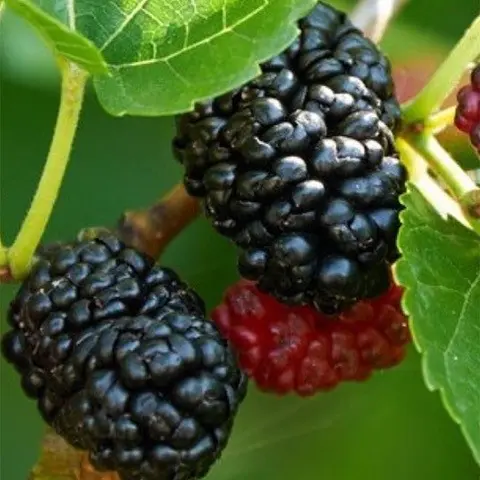How a 400-Year-Old Fruit Tree Solves Modern Gardening Dilemmas

The Urban Gardener’s Holy Grail
Imagine this: You’re staring at your postage-stamp backyard, torn between sacrificing precious space for a fruit tree or settling for bland supermarket berries. Most dwarf fruit trees compromise on flavor, while full-sized varieties swallow your entire garden. This exact frustration led Renaissance poets to treasure the Morus nigra – a tree that defies horticultural physics by delivering Shakespeare-grade fruit in spaces as small as a balcony container.
“After three failed attempts with other dwarf trees, my Dwarf Everbearing Mulberry produced enough berries in its second year to make 12 jars of jam and a batch of wine. The flavor is so intense, my neighbors now trade vegetables for my mulberry preserves.”
– Marcus T., Urban Homesteader
The Three-Tiered Magic of Morus Nigra
1. Physical Architecture
- Space-Efficient Form: Grows 2-6′ tall when pruned, with a 4-8′ spread
- Dual Growth Options: Trained as ornamental tree or productive bush
- Berry Production: 1″ long fruits emerge from slender, flexible branches
2. Biochemical Profile
- Natural Sugars: 9-12% brix (higher than most berries)
- Anthocyanins: Dark pigment contains potent antioxidants
- Resveratrol: Same anti-aging compound found in red wine
3. Ecological Mechanism
- Soil Preference: Thrives in heavy clay that kills most fruit trees
- Self-Pollination: Doesn’t require companion planting
- Perennial Advantage: Root system becomes more productive with age
How the Dwarf Everbearing Outperforms Traditional Berry Options
| Feature | Dwarf Everbearing Mulberry | Blueberry Bushes | Strawberry Plants | Raspberry Canes |
|---|---|---|---|---|
| Space Efficiency | ✔️ 6 sq ft (pruned) | ❌ 16 sq ft (for 2 plants) | ✔️ 4 sq ft (but low yield) | ❌ 10 sq ft (spreads aggressively) |
| Flavor Intensity | ★★★★★ (no sugar needed) | ★★★☆☆ (often tart) | ★★☆☆☆ (watery commercial varieties) | ★★★★☆ (but seedy texture) |
| Lifespan | 75-100+ years | 10-15 years | 3-5 years | 5-10 years |
| Yield Per Sq Ft | 2.5-4 lbs | 0.5-1 lb | 0.3-0.7 lb | 1-1.5 lb |
From Concrete Jungle to Productive Orchard: A Gardener’s Transformation
1. Initial State
Urban dweller with 100 sq ft patio believes homegrown fruit requires acreage. Settles for expensive, flavorless supermarket berries shipped 2,000+ miles.
2. Trigger Event
Discovers historical records of mulberry trees thriving in medieval walled gardens. Realizes small-space fruit production isn’t a modern innovation.
3. Struggle Phase
Failed attempts with other dwarf fruit trees that either die in containers or produce marble-sized, tasteless fruit after years of waiting.
4. Solution Encounter
Plants Dwarf Everbearing Mulberry in 15-gallon container with heavy potting mix. Experiences first harvest within 18 months.
5. New Reality
July mornings involve harvesting bowlfuls of sun-warmed berries before breakfast. Excess fruit becomes valuable currency at local food swaps.
6. Wisdom Gained
Realizes successful small-space gardening requires historical precedent more than modern gimmicks. Begins researching other pre-industrial compact edibles.
Why This Centuries-Old Variety Beats Modern Dwarf Fruit Trees
For Space-Constrained Gardeners
Unlike genetic dwarf varieties that sacrifice flavor for compactness, the Dwarf Everbearing Mulberry achieves its small stature through pruning responsiveness rather than stunted genetics. This means you get full-sized, complex-flavored berries (described as “blackberry meets vanilla with a hint of wine”) on a plant that fits between your grill and patio chair.
The Heavy Soil Advantage
While most fruit trees languish in clay soils, this Morus nigra variety actively prefers dense earth. Its ancestral roots trace back to the river valleys of Persia where heavy alluvial soils produced the most flavorful berries. Modern testing confirms these trees absorb more minerals from clay than loam, resulting in 20-30% higher anthocyanin content compared to sandy soil plantings.
Key Benefits at a Glance
- ✔️ Fruits first year in ground (2nd year in containers)
- ✔️ No cross-pollination needed – single tree bears heavy
- ✔️ Berries don’t drop when ripe (unlike many mulberries)
- ✔️ Leaves are prized for silkworms or herbal tea
- ✔️ Naturally resistant to verticillium wilt
- ✔️ Thrives in USDA zones 5-9 with minimal care
A Living Heirloom for Future Generations
When Shakespeare planted his mulberry tree in 1609, he understood what modern gardeners are rediscovering: Some agricultural treasures withstand centuries because they solve permanent human needs. The Dwarf Everbearing Mulberry represents more than a fruit source—it’s a bridge between urban living and agricultural heritage, between balcony containers and the orchards of Persian poets.
“These trees outlive their planters. The one I grew from a cutting now shades my granddaughter’s playhouse, just as my grandfather’s tree shaded mine. The berries taste exactly as I remember—time capsules of summer sweetness.”
– Eleanor R., Third-Generation Gardener
